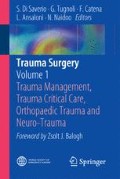Abstract
Major hemorrhage results in a switch from aerobic to anaerobic metabolism with a profound depletion of ATP. The primary goal of resuscitation is to revert to aerobic metabolism by addressing three major physiological disturbances, namely, hypoxia, hypoperfusion, and hypothermia. Early intubation and mechanical ventilation are essential interventions although protective lung ventilation should not be employed during the acute stage. Excessive use of clear resuscitation fluids should be avoided, and a massive transfusion protocol using blood and blood products in appropriate ratios must be instituted. Hypothermia is an independent predictor of mortality and rapid core rewarming is essential. Computerized scanning with angiography is the gold standard for the identification of injuries but should only be undertaken if physiology allows. Acute surgical intervention must address only life- or limb-threatening injuries and definitive fracture fixation undertaken at a later stage.
Access this chapter
Tax calculation will be finalised at checkout
Purchases are for personal use only
References
Stewart RM, Myers JG, Dent DL et al (2003) Seven hundred fifty-three consecutive deaths in a level I trauma center: the argument for injury prevention. J Trauma 54:66–70
Raymer JM, Flynn LM, Martin RF (2012) Massive transfusion of blood in the surgical patient. Surg Clin North Am 92:221–234
Muckart DJJ, Bhagwanjee S, Gouws E (1997) Validation of an outcome prediction model for critically ill trauma patients without head injury. J Trauma 43:934–938
Barbee RW, Reynolds PS, Ward KR (2010) Assessing shock resuscitation strategies by oxygen debt replacement. Shock 33:113–122
Cotton BA, Guillamondegui OD, Flemming SB et al (2008) Increased risk of adrenal insufficiency following etomidate exposure in critically injured patients. Arch Surg 143:62–67
The acute respiratory distress syndrome network (2000) Ventilation with lower tidal volumes as compared with traditional tidal volumes for acute lung injury and the acute respiratory distress syndrome. N Engl J Med 342(18):1301–1308
Paxian M, Bauer I, Rensing H et al (2003) Recovery of hepatocellular ATP and “pericentral apoptosis” after haemorrhage and resuscitation. FASEB J 17:993–1002
Riskin DJ, Tsai TC, Riskin L et al (2009) Massive transfusion protocols: the role of aggressive resuscitation versus product ratio in mortality reduction. J Am Coll Surg 209:198–205
Borgman MA, Spinella PC, Perkins JG et al (2007) The ratio of blood products transfused affects mortality in patients receiving massive transfusions at a combat support hospital. J Trauma 63(4):805–813
Kashuk JL, Moore EE, Johnson JL et al (2008) Postinjury life threatening coagulopathy: is 1:1 fresh frozen plasma:packed red blood cells the answer? J Trauma 65:261–271
McIntyre L, Hebert PC, Wells G et al (2004) Is a restrictive transfusion strategy safe for resuscitated and critically ill trauma patients? J Trauma 57:563–568
Kashuk JL, Moore EE (2009) The emerging role of rapid thromboelastography in trauma care. J Trauma 67:417–418
Gentilello LM, Pierson DJ (2001) Trauma critical care. Am J Respir Crit Care Med 163:604–607
Huber-Wagner S, Lefering R, Qvick LM et al (2009) Effect of whole-body CT during trauma resuscitation on survival: a retrospective, multicentre study. Lancet 373:1455–1461
Harwood PJ, Giannoudis PV, van Griensven M et al (2005) Alterations in the systemic inflammatory response after early total care and damage control procedures for femoral shaft fracture in severely injured patients. J Trauma 58:446–452
Crowl AC, Young JS, Kahler DM et al (2000) Occult hypoperfusion is associated with increased morbidity in patients undergoing early fracture fixation. J Trauma 48:260–267
Muckart DJJ, Thomson SR (1991) Undetected injuries: a preventable cause of increased morbidity and mortality. Am J Surg 162:457–460
Author information
Authors and Affiliations
Corresponding author
Editor information
Editors and Affiliations
Rights and permissions
Copyright information
© 2014 Springer-Verlag Italia
About this chapter
Cite this chapter
Muckart, D.J.J., Naidoo, N. (2014). Management of the Polytrauma Patient. In: Di Saverio, S., Tugnoli, G., Catena, F., Ansaloni, L., Naidoo, N. (eds) Trauma Surgery. Springer, Milano. https://doi.org/10.1007/978-88-470-5403-5_2
Download citation
DOI: https://doi.org/10.1007/978-88-470-5403-5_2
Published:
Publisher Name: Springer, Milano
Print ISBN: 978-88-470-5402-8
Online ISBN: 978-88-470-5403-5
eBook Packages: MedicineMedicine (R0)

